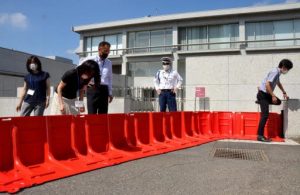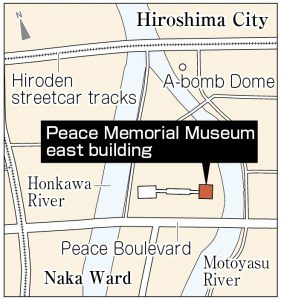Anticipating typhoon storm surges, Peace Museum adopts measures to protect A-bomb materials from flooding—installation of flood barriers, relocation of items to upper floors
Sep. 5, 2020
by Junji Akechi, Staff Writer
Amid a spate of flood damage caused by torrential rains and typhoons across Japan, the Hiroshima Peace Memorial Museum, located in the city’s Naka Ward, has come up with measures to protect A-bombing materials stored in the museum’s underground storage area from water damage. Simple, watertight flood barriers would be used to prevent water from entering the area and, if necessary, the materials would be evacuated to the museum’s upper floors. In preparation for typhoon season, the museum has been deliberating measures to avoid loss of valuable materials visibly damaged by the atomic bombing.
The measures were prepared in anticipation of potential damage caused by a storm surge from a major typhoon. If conditions related to tides and the typhoon course were to align unfavorably, water levels in the area around the museum’s east building, where the storage area is located, could rise to as high as one or two meters. Based on weather reports, if there were deemed to be a risk of flooding, two steps would be taken: first, installation of the plastic, watertight barriers (53 cm in height), and second, evacuation of the A-bombing materials.
The museum is located on a delta of land located between the Honkawa and Motoyasu rivers. The two places where water is likely to enter from the east and north sides of the building would be closed off with the watertight barriers. The museum purchased 15 such barriers for about 500,000 yen in August and conducted an installation test on September 1.
If the museum were to determine that the watertight barriers are insufficient in fully protecting the materials, the museum curators and other staff members would move the materials from the underground storage area to the museum’s upper floors. Clothing, paper materials, watches, and other small items that would be difficult to restore if stained by muddy water would be removed first. The time required for such a relocation of a minimum of materials is projected to be about three or four hours.
Kenji Tanaka, a professor (of hydrometeorology) at the Hiroshima Institute of Technology who advised the museum on the work, praised the measures. “These are the most practical actions that can be taken on site.” However, he pointed out that, in the long run, the risk of storm surges would increase due to such factors as rising sea levels caused by global warming. He suggested enhancement of measures related to the physical infrastructure of the museum at the time of large-scale renovations of the facility.
A typhoon that hit Japan in October last year flooded the entire underground storehouse of the Kawasaki City Museum, damaging some 230,000 items, including archeological materials and artwork. In February, at the first meeting of the Peace Memorial Museum’s expert committee, which advises on museum operations, several committee members called for immediate measures to be adopted.
The recently developing typhoon No. 10 is expected to make its closest approach to the Chugoku region of Japan on the morning of September 7. Shuichi Kato, deputy director of the museum, said, “The A-bombing materials cannot be recovered if lost. Keeping a close eye on the typhoon forecast, we are ready to put in place the watertight barriers at any time.” The measures are to be unveiled at the next expert committee meeting, where comments and opinions will be elicited from members.
(Originally published on September 5, 2020)
Amid a spate of flood damage caused by torrential rains and typhoons across Japan, the Hiroshima Peace Memorial Museum, located in the city’s Naka Ward, has come up with measures to protect A-bombing materials stored in the museum’s underground storage area from water damage. Simple, watertight flood barriers would be used to prevent water from entering the area and, if necessary, the materials would be evacuated to the museum’s upper floors. In preparation for typhoon season, the museum has been deliberating measures to avoid loss of valuable materials visibly damaged by the atomic bombing.
The measures were prepared in anticipation of potential damage caused by a storm surge from a major typhoon. If conditions related to tides and the typhoon course were to align unfavorably, water levels in the area around the museum’s east building, where the storage area is located, could rise to as high as one or two meters. Based on weather reports, if there were deemed to be a risk of flooding, two steps would be taken: first, installation of the plastic, watertight barriers (53 cm in height), and second, evacuation of the A-bombing materials.
The museum is located on a delta of land located between the Honkawa and Motoyasu rivers. The two places where water is likely to enter from the east and north sides of the building would be closed off with the watertight barriers. The museum purchased 15 such barriers for about 500,000 yen in August and conducted an installation test on September 1.
If the museum were to determine that the watertight barriers are insufficient in fully protecting the materials, the museum curators and other staff members would move the materials from the underground storage area to the museum’s upper floors. Clothing, paper materials, watches, and other small items that would be difficult to restore if stained by muddy water would be removed first. The time required for such a relocation of a minimum of materials is projected to be about three or four hours.
Kenji Tanaka, a professor (of hydrometeorology) at the Hiroshima Institute of Technology who advised the museum on the work, praised the measures. “These are the most practical actions that can be taken on site.” However, he pointed out that, in the long run, the risk of storm surges would increase due to such factors as rising sea levels caused by global warming. He suggested enhancement of measures related to the physical infrastructure of the museum at the time of large-scale renovations of the facility.
A typhoon that hit Japan in October last year flooded the entire underground storehouse of the Kawasaki City Museum, damaging some 230,000 items, including archeological materials and artwork. In February, at the first meeting of the Peace Memorial Museum’s expert committee, which advises on museum operations, several committee members called for immediate measures to be adopted.
The recently developing typhoon No. 10 is expected to make its closest approach to the Chugoku region of Japan on the morning of September 7. Shuichi Kato, deputy director of the museum, said, “The A-bombing materials cannot be recovered if lost. Keeping a close eye on the typhoon forecast, we are ready to put in place the watertight barriers at any time.” The measures are to be unveiled at the next expert committee meeting, where comments and opinions will be elicited from members.
(Originally published on September 5, 2020)









